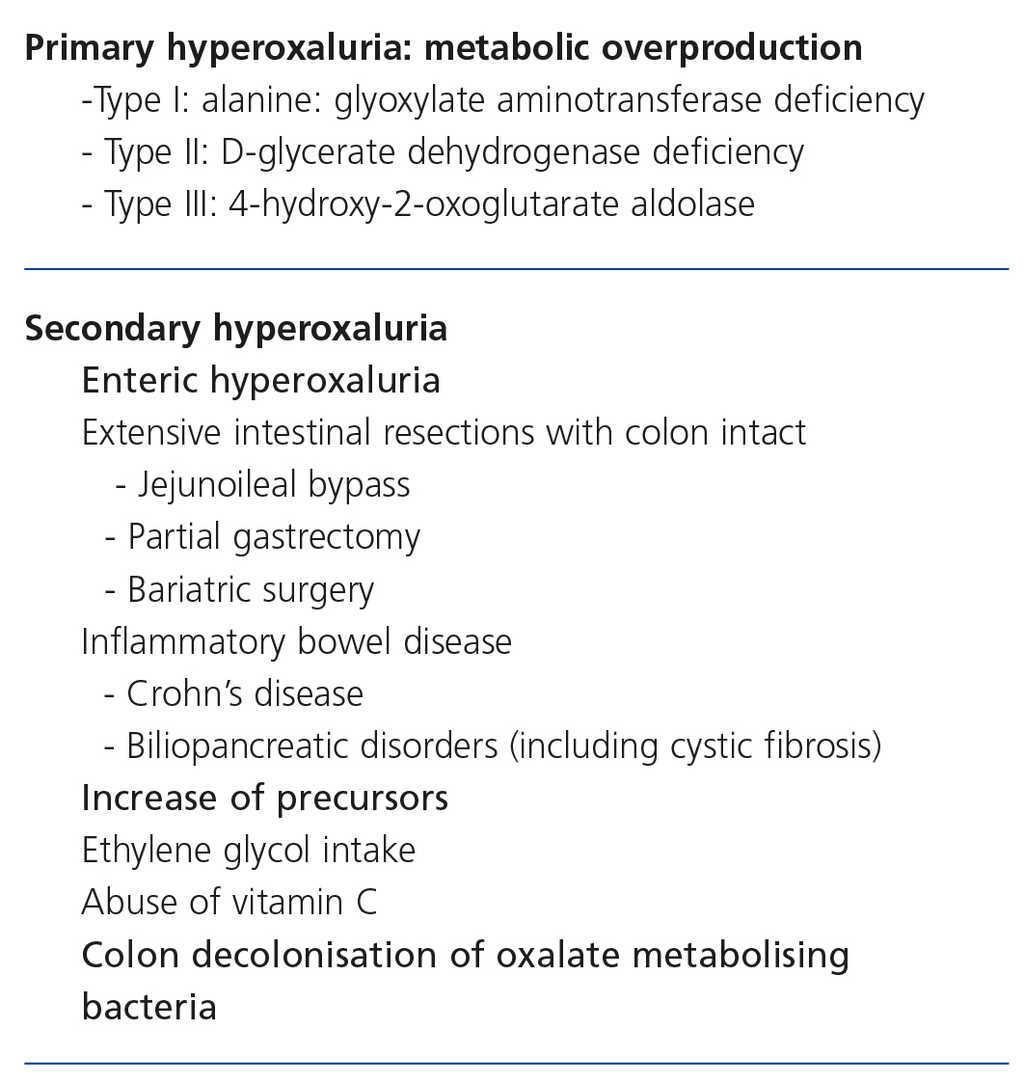So you’ve recently heard the term “hyperoxaluria” and you’re curious to know more about it. Hyperoxaluria is a medical condition characterized by high levels of oxalate in your urine, which can lead to the formation of kidney stones and other complications. In this article, we will explore the causes, symptoms, and potential treatment options for hyperoxaluria, shedding light on this often misunderstood condition. Get ready to dive into the world of hyperoxaluria, where understanding the intricacies of this condition can make a significant difference in managing its effects on your health.
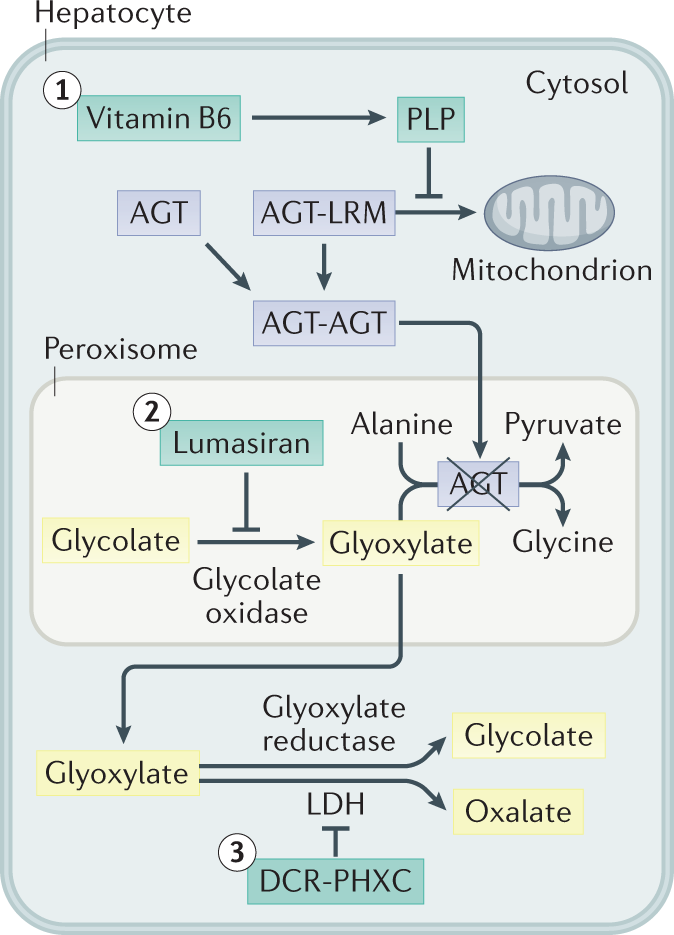
This image is property of media.springernature.com.
Overview of Hyperoxaluria
Hyperoxaluria is a medical condition characterized by an excessive level of oxalate in the urine. Oxalate is a natural substance found in many foods and is also produced by the body. In normal amounts, oxalate is eliminated through the kidneys. However, in individuals with hyperoxaluria, the body produces too much oxalate or is unable to properly eliminate it, leading to the formation of kidney stones and potential kidney damage.
Definition and Causes
Hyperoxaluria is defined as a condition where the oxalate levels in the urine are higher than normal. This happens either due to overproduction of oxalate in the body or a decreased ability of the kidneys to effectively eliminate oxalate.
There are several causes of hyperoxaluria, including genetic factors, certain digestive disorders that affect the absorption of calcium and fats, and certain medications. Primary hyperoxaluria is a genetic condition caused by mutations in genes involved in the metabolism of oxalate. On the other hand, secondary hyperoxaluria is commonly caused by conditions such as kidney disease, gastrointestinal disorders, and dietary factors.
Prevalence
Hyperoxaluria is considered a rare condition, affecting approximately 1 in 7,000 to 1 in 100,000 people worldwide. The prevalence may vary depending on the type of hyperoxaluria. Primary hyperoxaluria is the less common form, accounting for about 1 in 100,000 individuals, while secondary hyperoxaluria is more prevalent and often associated with underlying health conditions.
Types of Hyperoxaluria
There are three main types of hyperoxaluria:
-
Type 1 (Primary Hyperoxaluria): This is the most severe and rare form of hyperoxaluria, caused by a mutation in the AGXT gene. It typically manifests in childhood.
-
Type 2 (Primary Hyperoxaluria): This type is caused by mutations in the GRHPR gene. It tends to have a slightly milder course compared to type 1.
-
Type 3 (Secondary Hyperoxaluria): Secondary hyperoxaluria occurs secondary to other underlying health conditions, such as kidney disease, inflammatory bowel disease, and malabsorption disorders.
Symptoms
The symptoms of hyperoxaluria can vary depending on the type and severity of the condition. Some common symptoms include:
-
Recurrent kidney stones: Hyperoxaluria increases the risk of kidney stone formation, which can cause severe pain and discomfort in the lower back or abdomen. Blood in the urine and frequent urination are also common.
-
Fatigue and weakness: The excess oxalate in the body can lead to malabsorption of important nutrients, causing fatigue and weakness.
-
Kidney damage: Prolonged or recurring episodes of kidney stones can result in kidney damage over time.
Diagnosis
Diagnosing hyperoxaluria involves a combination of medical history, physical examination, and laboratory tests. The healthcare provider may evaluate symptoms, family history, and perform a urine test to measure oxalate levels. Genetic testing may be necessary to confirm the diagnosis of primary hyperoxaluria.
Treatment
The treatment approach for hyperoxaluria depends on the type and severity of the condition. The primary goal of treatment is to reduce the levels of oxalate in the body and prevent the formation of kidney stones.
Potential treatment options may include:
-
Medications: Medications such as calcium citrate or potassium citrate may be prescribed to bind with oxalate in the digestive system and decrease its absorption.
-
Increased fluid intake: Drinking plenty of fluids helps to dilute the urine and reduce the concentration of oxalate.
-
Dietary changes: A low-oxalate diet may be recommended, which involves avoiding foods high in oxalate and increasing intake of calcium-rich foods to help bind with oxalate in the gut.
-
Management of underlying conditions: In cases of secondary hyperoxaluria, treating the underlying condition or disease may be necessary to reduce oxalate levels.
Primary Hyperoxaluria
Introduction
Primary hyperoxaluria is a group of rare genetic disorders that result in the excessive production of oxalate in the body. This condition is typically inherited and can lead to the accumulation of oxalate in various organs, particularly the kidneys.
Types
There are two main types of primary hyperoxaluria:
-
Type 1: This is the most common and severe form of primary hyperoxaluria. It is caused by mutations in the AGXT gene.
-
Type 2: Type 2 primary hyperoxaluria is caused by mutations in the GRHPR gene. It tends to have a slightly milder course compared to type 1.
Causes
Primary hyperoxaluria is a genetic condition that is inherited in an autosomal recessive manner. Mutations in specific genes involved in the metabolism of oxalate lead to the overproduction of oxalate. The exact cause of these mutations is not fully understood, but they can be passed down from parents to their children.
Symptoms
Symptoms of primary hyperoxaluria may vary depending on the type and severity of the condition. Common symptoms include:
-
Recurrent kidney stones: The excessive oxalate in the body can form crystals that accumulate in the kidneys, leading to the formation of kidney stones.
-
Kidney damage: Over time, the presence of kidney stones can cause damage to the kidneys, resulting in reduced kidney function.
-
Calcification in other organs: In some cases, oxalate can accumulate in other organs, such as the heart, blood vessels, and eyes, causing calcification and impairing their function.
Diagnosis
Diagnosing primary hyperoxaluria involves a combination of medical history, physical examination, and laboratory tests. A urine test may be conducted to measure the level of oxalate, and genetic testing can confirm the specific type of primary hyperoxaluria.
Treatment
Treatment for primary hyperoxaluria aims to reduce the production and accumulation of oxalate in the body, as well as manage complications such as kidney stones. Some treatment options may include:
-
Medications: Depending on the type of primary hyperoxaluria, specific medications may be prescribed to reduce the production of oxalate or increase its elimination.
-
Kidney transplantation: In severe cases where the kidneys are extensively damaged, a kidney transplantation may be necessary to improve kidney function.
-
Supportive care: Individuals with primary hyperoxaluria may require ongoing monitoring and management of kidney function and associated complications.
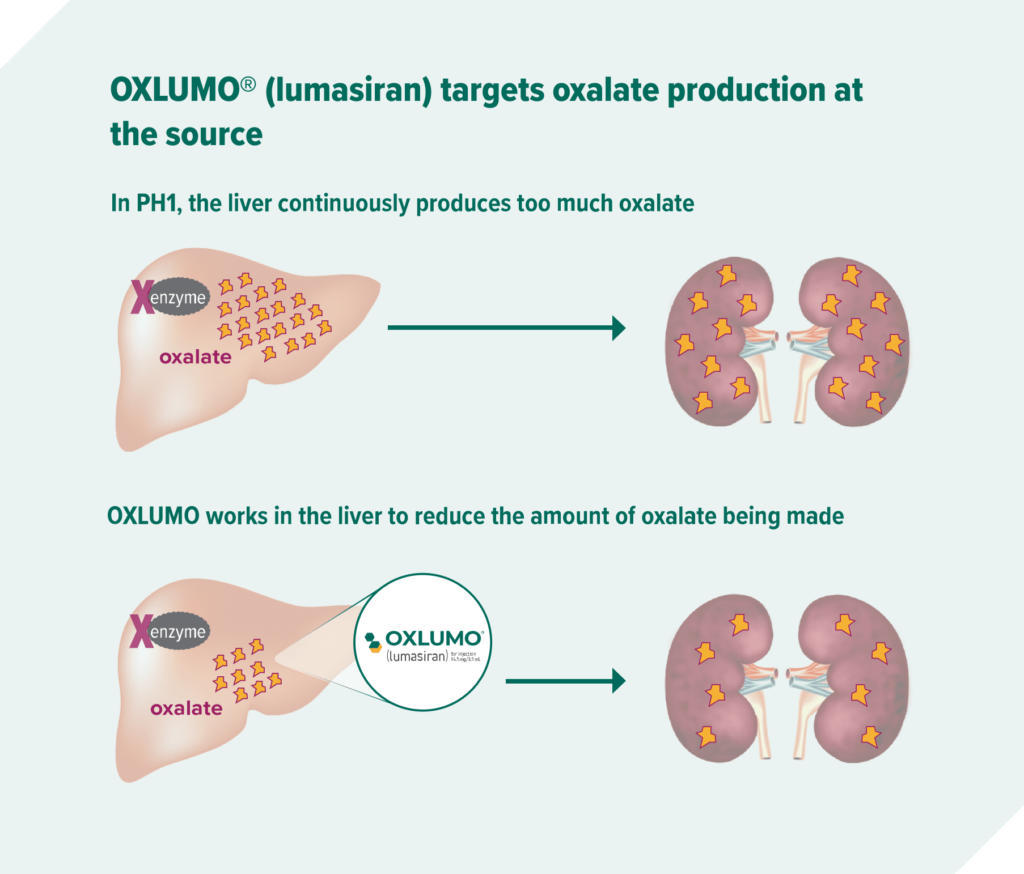
This image is property of www.oxlumo.com.
Secondary Hyperoxaluria
Introduction
Secondary hyperoxaluria is a form of hyperoxaluria that occurs secondary to other underlying health conditions or external factors. It is more common compared to primary hyperoxaluria and is often associated with kidney disease or gastrointestinal disorders.
Causes
Secondary hyperoxaluria can be caused by various factors, including:
-
Kidney disease: Certain kidney disorders, such as chronic kidney disease or end-stage renal disease, can lead to an increased risk of secondary hyperoxaluria.
-
Gastrointestinal disorders: Conditions that affect the digestion and absorption of dietary fats and calcium, such as inflammatory bowel disease or malabsorption disorders, can contribute to the development of secondary hyperoxaluria.
-
Medications: Some medications, including those used to treat certain gastrointestinal conditions or antibiotics, can increase oxalate levels in the urine and contribute to secondary hyperoxaluria.
Symptoms
The symptoms of secondary hyperoxaluria are similar to those of primary hyperoxaluria and generally include:
-
Recurrent kidney stones: Increased oxalate in the urine can lead to the formation of kidney stones, resulting in symptoms such as back or abdominal pain, blood in the urine, and frequent urination.
-
Kidney damage: Prolonged episodes of kidney stones can lead to kidney damage and impaired kidney function.
Diagnosis
The diagnosis of secondary hyperoxaluria involves evaluating the individual’s medical history, conducting a physical examination, and performing urine and blood tests. Identifying the underlying condition or factor contributing to the hyperoxaluria is crucial for accurate diagnosis and appropriate treatment.
Treatment
Treatment for secondary hyperoxaluria primarily focuses on managing the underlying condition or factor contributing to the high oxalate levels. This may involve:
-
Treating kidney disease: Managing underlying kidney disease is essential in reducing oxalate levels and preventing the progression of secondary hyperoxaluria.
-
Addressing gastrointestinal disorders: Treating conditions that disrupt the absorption of fats and calcium in the digestive system can help reduce oxalate levels.
-
Medication adjustments: If certain medications are contributing to hyperoxaluria, the healthcare provider may recommend adjustments or alternatives.
Diet and Hyperoxaluria
Role of Diet in Hyperoxaluria
Diet plays a significant role in managing hyperoxaluria. Certain foods contain high levels of oxalate, which can contribute to the excessive oxalate levels in the body. By following a low-oxalate diet, individuals with hyperoxaluria can help reduce their oxalate intake and lessen the risk of kidney stone formation.
Foods to Avoid
For individuals with hyperoxaluria, it is important to limit or avoid foods that are high in oxalate. Some examples of foods to avoid or consume in moderation include:
- Spinach
- Rhubarb
- Beets
- Swiss chard
- Almonds
- Cashews
- Chocolate
- Tea
- Soy products
It is important to note that cooking or boiling certain high-oxalate foods can help reduce the oxalate content. However, it is advisable to consult with a healthcare professional or registered dietitian for personalized dietary recommendations.
Foods to Include
While it is necessary to limit high-oxalate foods, individuals with hyperoxaluria should still maintain a nutritious and balanced diet. Some foods that are generally lower in oxalate and can be included in a hyperoxaluria-friendly diet include:
- Low-fat dairy products, such as milk, cheese, and yogurt
- Fruits like apples, grapes, and melons
- Vegetables like broccoli, cauliflower, and carrots
- Lean meats, poultry, and fish
- Whole grains, including oats and quinoa
Tips for managing Hyperoxaluria with Diet
In addition to avoiding high-oxalate foods and incorporating lower-oxalate alternatives, there are some additional tips that can help manage hyperoxaluria through diet:
-
Stay hydrated: Drinking an adequate amount of fluids can help dilute urine and reduce the concentration of oxalate.
-
Consume calcium-rich foods: Including calcium-rich foods in the diet can help bind with oxalate in the gut, reducing its absorption.
-
Spread oxalate intake throughout the day: Rather than consuming foods high in oxalate all at once, spreading the intake throughout the day can help minimize the oxalate load on the kidneys.
-
Consider working with a dietitian: Consulting a registered dietitian who specializes in managing hyperoxaluria can provide useful guidance and personalized dietary recommendations.
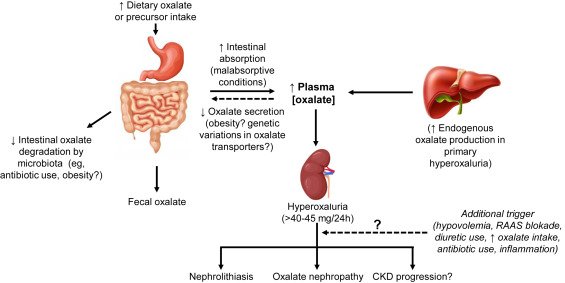
This image is property of ars.els-cdn.com.
Complications of Hyperoxaluria
Kidney Stones
One of the most significant complications of hyperoxaluria is the development of kidney stones. The excess oxalate in the urine can form crystals, which can then accumulate and grow into kidney stones. Kidney stones can cause severe pain, blood in the urine, and may require medical intervention to be passed or removed.
Kidney Damage
Prolonged or recurring episodes of kidney stones in hyperoxaluria can lead to kidney damage. The presence of oxalate crystals and repeated blockages can impair the function of the kidneys, potentially resulting in decreased kidney function or chronic kidney disease.
Chronic Kidney Disease
Severe or poorly managed hyperoxaluria can ultimately lead to chronic kidney disease (CKD), a progressive condition characterized by a decline in kidney function. CKD can have a significant impact on an individual’s overall health and may require ongoing medical management, including potential dialysis or kidney transplantation.
Prevention and Management
Preventing Hyperoxaluria
Preventing hyperoxaluria is challenging, particularly for individuals with primary hyperoxaluria that is genetically inherited. However, certain measures can help reduce the risk of developing secondary hyperoxaluria. These include:
-
Managing kidney health: Maintaining good kidney health by staying hydrated, avoiding excessive salt and protein intake, and following a balanced diet can help prevent the development of kidney stones and secondary hyperoxaluria.
-
Treating underlying conditions: Managing gastrointestinal disorders, kidney disease, and other conditions that can contribute to secondary hyperoxaluria is important in preventing its occurrence.
-
Medication review: Regular medication review with a healthcare provider can help identify any medications that may increase the risk of secondary hyperoxaluria, and adjustments can be made if necessary.
Managing Hyperoxaluria
Effective management of hyperoxaluria involves a combination of lifestyle changes, dietary modifications, and medical interventions. Some strategies for managing hyperoxaluria include:
-
Medications: Depending on the type and severity of the hyperoxaluria, specific medications may be prescribed to reduce oxalate production or increase its elimination.
-
Dietary modifications: Following a low-oxalate diet and making suitable substitutions can help reduce oxalate intake and minimize the risk of kidney stone formation.
-
Increased fluid intake: Staying adequately hydrated is crucial in preventing the concentration of oxalate in urine and reducing the risk of kidney stone formation.
Lifestyle Changes
Making certain lifestyle changes can also contribute to managing hyperoxaluria. These include:
-
Regular physical activity: Engaging in regular exercise can promote overall health and may help reduce the risk of kidney stone formation.
-
Avoiding excessive salt intake: High salt consumption can increase the formation of calcium-based kidney stones, which can exacerbate the complications of hyperoxaluria.
-
Limiting alcohol consumption: Alcohol can dehydrate the body and increase the risk of kidney stone formation. Limiting alcohol intake is advisable for individuals with hyperoxaluria.
Follow-up Care
Regular follow-up care with a healthcare provider or specialist is important for individuals with hyperoxaluria. This allows for ongoing monitoring of kidney function, assessment of treatment effectiveness, and adjustments in management as necessary.
Supportive Therapies
In addition to medical interventions, certain supportive therapies may be recommended to manage complications of hyperoxaluria. These can include:
-
Kidney stone prevention measures: Adopting measures to prevent kidney stone formation, such as maintaining a low-oxalate diet, increasing fluid intake, and managing underlying conditions, may help reduce the recurrence of kidney stones.
-
Kidney transplantation: In severe cases of primary hyperoxaluria or end-stage kidney disease, kidney transplantation may be considered as a treatment option to improve kidney function.
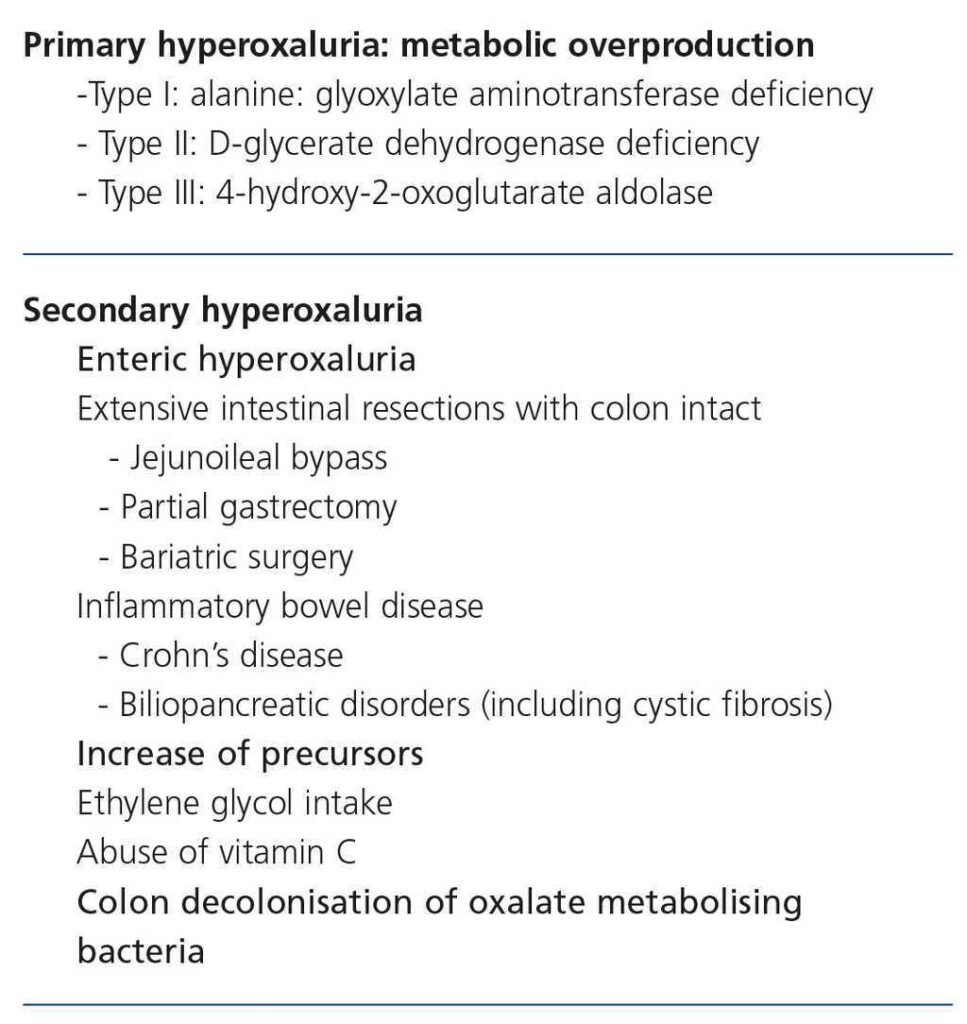
This image is property of multimedia.elsevier.es.
Research and Future Perspectives
Current Research on Hyperoxaluria
Research on hyperoxaluria continues to uncover new insights into the underlying causes, diagnostic approaches, and potential treatment options. Ongoing studies aim to better understand the genetic mechanisms behind primary hyperoxaluria and explore innovative therapies.
Potential Therapies and Interventions
Several potential therapies and interventions are being investigated for the treatment of hyperoxaluria. These include:
-
Enzyme replacement therapy: For individuals with primary hyperoxaluria, enzyme replacement therapy to provide the missing or malfunctioning enzyme involved in oxalate metabolism is being explored as a potential treatment option.
-
Gene therapy: Researchers are investigating the use of gene therapy techniques to correct the genetic mutations responsible for primary hyperoxaluria and potentially reduce or eliminate oxalate overproduction.
-
Novel medication approaches: New medications targeting specific pathways involved in oxalate production or elimination are being developed and tested in clinical trials.
Future Outlook
The future outlook for individuals with hyperoxaluria looks promising, with ongoing research and advancements in treatments. Through improved understanding of the genetic causes, better diagnostic methods, and innovative therapies, it is hoped that the management and outcomes for individuals with hyperoxaluria will continue to improve. Continued collaboration between scientists, healthcare professionals, and individuals affected by the condition will be crucial in driving progress and finding effective solutions for this rare disorder.

